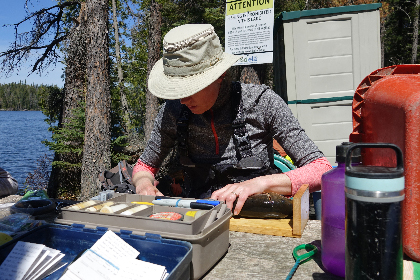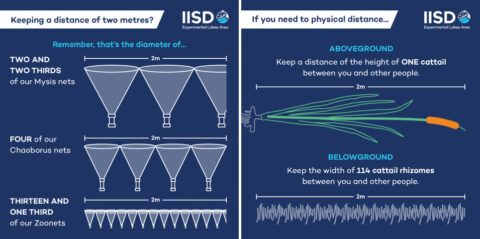The International Institute for Sustainable Development Experimental Lakes Area (IISD-ELA) sits in a remote wilderness area of northwestern Ontario, Canada. Of the thousands of glacial-scoured water bodies that dot this region, its 58 lakes are part of a unique living laboratory where the hydrology, chemistry, and limnology—the biological study of lakes—have been studied since 1968.
Over the 52 years of data collection at IISD-ELA, there have been numerous bumps along the road. Funding crunches and shifting government priorities have more than once threatened the station’s existence. In 1973, a windstorm tore up trees like toothpicks. A 1980 forest fire nearly consumed the field station’s buildings. After enduring these onslaughts, as well as severe snowstorms and floods, the field station now faces a new challenge: the coronavirus disease of 2019, or COVID-19.
First opened as a temporary location for research on nutrient pollution, the internationally renowned site has become famous for its scientific impact on international policies around air pollution and phosphates, as well as decades of data sets on hydrology, water chemistry, biology, and climate.
At IISD-ELA, whole lakes are manipulated like giant, ecologically functioning test tubes, with untouched lakes acting as experimental controls. Whole-lake experimental manipulations have involved additions of acid, nutrients, mercury, radioactivity, iron, and synthetic estrogens, allowing researchers to see the environmental impacts of these stressors on freshwater systems. Another unplanned long-term experiment—climate change—has provided an additional limnological learning opportunity.
Defining a New Normal

In a normal year, summer is the research station’s busiest season. As the icy winter thaws, more than 50 researchers and staff typically converge to live and work in this land of lakes and curious minds. Field research usually involves close collaboration, shared eating spaces, and centralized sleeping quarters in dormitories. But group living presents a formidable challenge amid the novel coronavirus pandemic. To balance safety with continuity of the site’s 52-year unbroken data sets, IISD-ELA has adapted to a new normal—at least for the time being.
IISD-ELA staff biologist Lee Hrenchuk was already at IISD-ELA doing regularly scheduled winter sampling as the new reality began to dawn. As part of the station’s fish crew, she regularly catches sentinel species like lake trout in experimental and control lakes to study their growth rates, condition, and survival.
Hrenchuk and her colleagues quickly assessed how normal protocols might be adapted.
“We sat down one evening and spent 3 or 4 hours hashing out what we thought would be a doable sampling protocol,” said Hrenchuk, explaining that it needed to be one requiring a minimum of people and time.
Even before COVID-19, staff at IISD-ELA knew that because of the usually close communal nature of life at a remote field camp, infections can spread easily.
Even before COVID-19, staff at IISD-ELA knew that because of the communal nature of life at a remote field camp, infections can spread easily. “Once a cold or a flu gets into camp, everybody gets it,” said the site’s head research scientist Vince Palace.
At the site, summer fieldwork has already begun, and instead of 50 or more residents in camp—a number that sometimes rises to 100 visitors including daytime tours—the small crew will include, at most, eight scientists, two facilities maintenance staff, and one cook.
Prior to heading to the site, every researcher will self-isolate at home for 14 days. Additionally, staff alternates will also self-isolate so they are available for work in case someone at camp gets sick.
Once individuals arrive at camp, there will be a vehicle cleaning protocol and another before they leave. Whereas accommodations are usually shared dormitories, this summer each researcher will have a separate sleeping cabin. Gloves have always been worn when handling fish, explained Hrenchuk, but other protocols like physical distancing will be carefully observed when getting in and out of boats, using walking trails, going into buildings and vehicles, and collecting data from flowmeters and meteorological stations. Any shared equipment will be frequently sanitized, and chemical analyses of water samples will be done by the chemistry staff in a laboratory building on site.
In Hungry Hall, where field crew eat, dining tables are now spread far apart. “Shouting across the dining room to have a conversation—stuff like that is different,” said Hrenchuk, emphasizing that new procedures are all about physical separation. As a reminder, IISD-ELA even created some infographics explaining social distancing in site-specific terms.

One of the unfortunate repercussions of COVID-19 will be pressing pause on new research. Continuity for the long-term data collection is now the priority, so most other research, like investigating the impacts of oil spills, microplastics, and cannabis and other drugs on freshwater ecosystems, has been delayed.
Hrenchuk acknowledged that it will be a very different summer at IISD-ELA. Nevertheless, despite the long days and hard work that field research will entail with just a few crew members doing the job of many, when it comes to getting out to the lakes this summer after sheltering in place in the city, she said, “we are all excited to leave our house.”
—Lesley Evans Ogden (@ljevanso), Science Writer
Citation:
Evans Ogden, L. (2020), Fieldwork in the Experimental Lakes Area adapts to COVID-19, Eos, 101, https://doi.org/10.1029/2020EO145085. Published on 03 June 2020.
Text © 2020. The authors. CC BY-NC-ND 3.0
Except where otherwise noted, images are subject to copyright. Any reuse without express permission from the copyright owner is prohibited.

